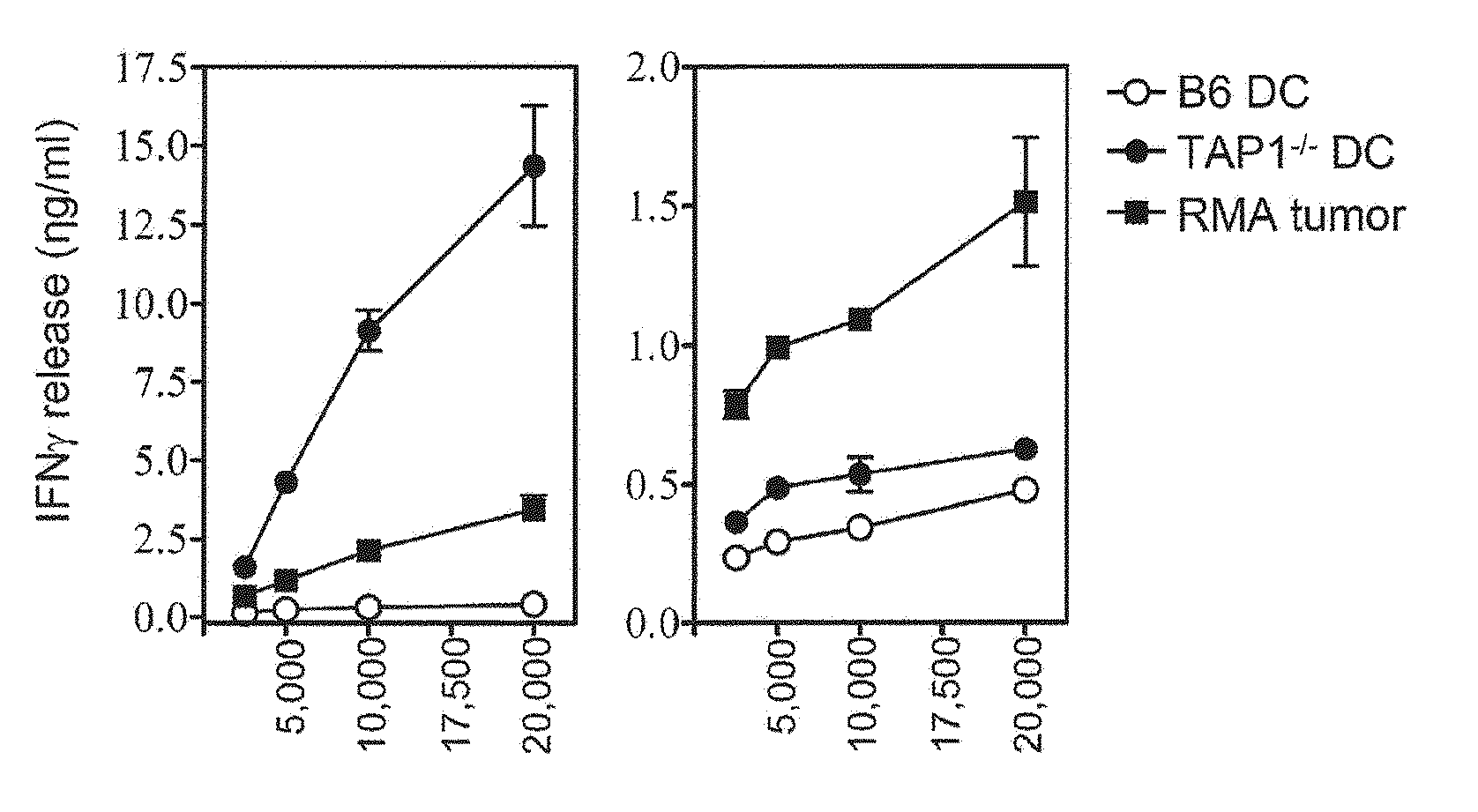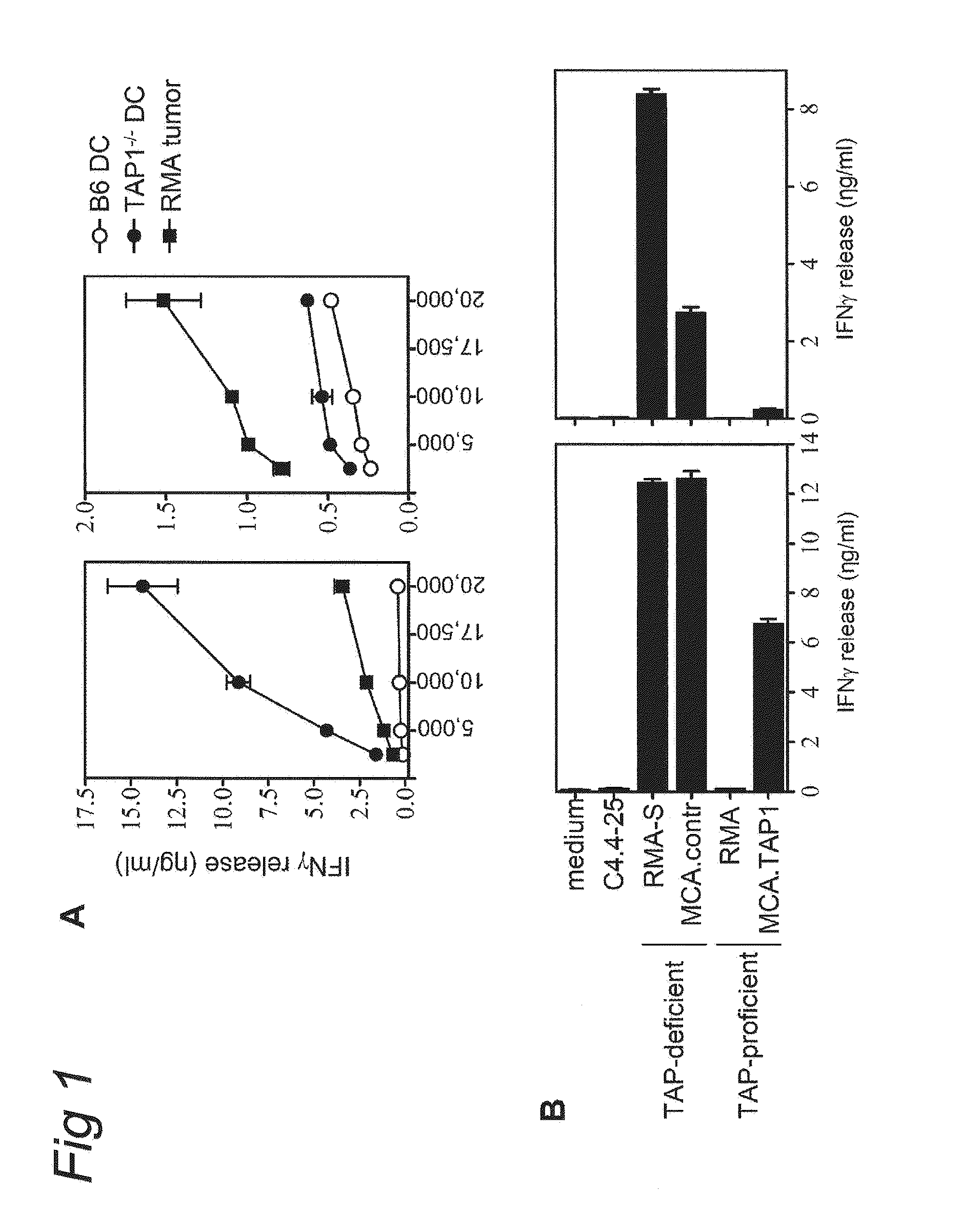Use of a varicellovirus tap-inhibitor for the induction of tumor-or virus-specific immunity against teipp
- Summary
- Abstract
- Description
- Claims
- Application Information
AI Technical Summary
Benefits of technology
Problems solved by technology
Method used
Image
Examples
example 1
1. Example 1
TAP-Inhibiting Proteins US6, ICP47 and UL49.5 Differentially Affect Minor and Major Histocompatibility Antigen-Specific Recognition by Cytotoxic T Lymphocytes
1.1 Materials and Methods
1.1.1 Retroviral Constructs
[0050]cDNA's encoding the viral proteins US6, ICP47 and UL49.5 were generated by PCR under standard conditions. Plasmids containing the US6 and ICP47 genes were kind gifts of Dr. J. Neefjes (Dutch Cancer Institute, Amsterdam) and Dr. K. Frith (Vaccine and Gene Therapy Institute, Oregon Health and Science University), respectively. The PCR-generated products were inserted into the pLZRS-polylinker-IRES-eGFP retroviral vector (http: / / www.stanford.edu / group / nolan / protocols / pro_helper_free.html) upstream of the internal ribosomal entry site (IRES) and enhanced GFP. Retrovirus production and transduction of EBV-LCL were performed as described (http: / / www.stanford.edu / group / nolan / protocols / pro_helper_free.html).
1.1.2 Cell Lines
[0051]EBV-LCLs Modo and Hodo (Table 1) were ...
example 2
2. Example 2
UL49.5 Regulates the Presentation of Murine CTL Epitopes by Qa-1b
2.1 Materials and Methods
[0064]2.1.1 Cell lines The tumor cell lines used in this study have been generated by chemical carcinogens in different mouse strains. Coloncarcinoma C26 and CC36 were derived from the BALB / c stain and MC38 was derived from the C57BL / 6 strain (34). Introduction of the UL49.5 gene from bovine herpesvirus 1 (BHV1) was established by retroviral gene transduction with the LZRS vector containing an IRES GFP, as described before (21). Cells with the highest GFP expression were positively sorted by FACS. Fibrosarcoma MCA was generated in the TAP1− / − mouse on C57BL / 6 background (24). TAP1 restoration in this cell line was performed with a retroviral construct encoding the mouse TAP1 gene, as described (24). CTL clone E / 88 recognizes the H-2Ld-binding peptide SPSYVYHQF comprised in an endogenous retroviral gp70 gene product and was generously provided by Dr. M. Colombo (35). These CTL were w...
example 3
3. Example 3
Dendritic Cells Deficient for the Peptide Transporter Tap Arouse Protective CTL Immunity Against Tumor Immune Escape Variants
3.1 Material and Methods
3.1.1 Cell Lines and Mice
[0075]Tumor cell lines used in this study, RMA-S lymphoma and MCA fibrosarcoma were described before (24). D1 cells are growth factor-dependent immature dendritic cells and were kindly provided by Dr. F. Ossendorp (39). Mouse TAP1 gene and the Bovine Herpes Virus-1 derived gene UL49.5, which was kindly provided by Dr. E. Wiertz, were cloned into retroviral plasmid vector LZRS and gene transduction was performed as previously described (in Example 2 and 2 1). In this study several TEIPP-specific CTL clones are used: c1G, c1B5 and mi3. All display similar specificity for TAP-deficient target cells. Tumor-specific CTL clone c117 recognizes the peptide NKGENAQAI as presented by RMA cells (37). CTL were weekly restimulated with irradiated tumor cells (RMA-S.B7 and RMA, respectively) together with 10 Cetus...
PUM
| Property | Measurement | Unit |
|---|---|---|
| Fraction | aaaaa | aaaaa |
| Fraction | aaaaa | aaaaa |
| Fraction | aaaaa | aaaaa |
Abstract
Description
Claims
Application Information
 Login to View More
Login to View More - R&D
- Intellectual Property
- Life Sciences
- Materials
- Tech Scout
- Unparalleled Data Quality
- Higher Quality Content
- 60% Fewer Hallucinations
Browse by: Latest US Patents, China's latest patents, Technical Efficacy Thesaurus, Application Domain, Technology Topic, Popular Technical Reports.
© 2025 PatSnap. All rights reserved.Legal|Privacy policy|Modern Slavery Act Transparency Statement|Sitemap|About US| Contact US: help@patsnap.com



